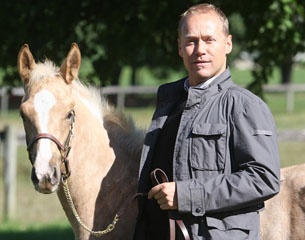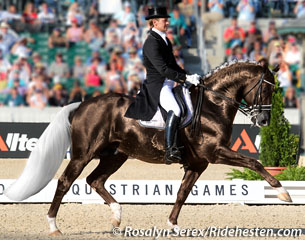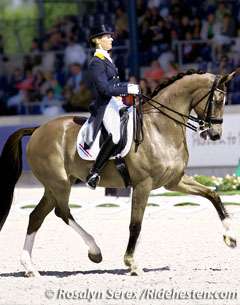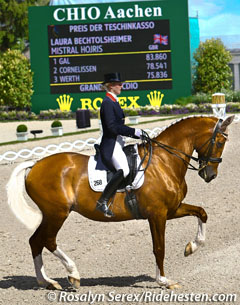
Guest columnist of the week is Thomas Bach Jensen, journalist for the popular Danish equestrian magazine Ridehesten.com and press officer for the Danish Warmblood Society. Bach Jensen has worked for the Danish Foreign Ministry
in Brussels for a number of years and worked as a freelance journalist for various equestrian magazines including Eurodressage.com. He is a passionate painter and renowned for his marvellous oil paintings of famous dressage stallions. Bach Jensen is now full-time employed by Ridehesten.
When first approached with the question if I would produce the next Eurodressage guest column I thought I would pick a subject within our sport. The number of interesting issues within dressage is endless and so is the number of professionals much better qualified than I am to comment on such matters, so that was a no-go for me, and my views on how pathetic I consider the fact that the Danish Equestrian Federation is unable or rather unwilling to find a way to cooperate with the Danish breeding in creating a national championship for young horses probably has little international interest.
Most people who know my background would expect me to write about the successful breeding of Danish dressage horses, but would that not be too obvious coming from my side? And it could easily develop into an obnoxiously long tale. I have recently broadened my knowledge about active stabling where horses live a better life moving freely around in a large paddock socializing with other horses and carrying a micro chip which activates the feed distributors to release small amounts of feed many times a day in order for the horses not to colic. It seems brilliant and is even cost-saving, but no matter how ideal it all occurs, it is not going to be my topic. I have decided on a more colourful palette for the New Year.
Where did the colours go?
 A brief glance at the FEI world ranking of dressage horses reveals a lot of blacks, chestnuts and bays. Even the odd grey horse, but then that is practically the end of the colour variety. The colours of the modern dressage horse are chestnut, black, bay and grey, and we all know that the colour really does not matter. “A good horse has no colour” they say.
A brief glance at the FEI world ranking of dressage horses reveals a lot of blacks, chestnuts and bays. Even the odd grey horse, but then that is practically the end of the colour variety. The colours of the modern dressage horse are chestnut, black, bay and grey, and we all know that the colour really does not matter. “A good horse has no colour” they say.
As a painter I have often enjoyed studying 18th century paintings of noble knights and their fearless mounts of rare beauty. These outstandingly elegant horses wearing exclusive leather tack decorated with gold, precious stones and silk must have been some of the best horses in their time and some must have been the forefathers of the modern sport horses.
These horses, portrayed by renowned painters, came in all colours. Some were solid bays, some flaxen chestnuts and others were black with a blanket of leopard spots. Some were blue roan, some were palomino, while others were silver dapple, piebald, red dun, smoky black, ivory or amber champagne, skewbald, perlino, full spotted leopard, red dun, buckskin with snowflakes, chestnut pangare, dapple grey, grulla, even brindle or simply black! But where did all the colours go?
Breeding for Distinct Colour
 We are very proud to claim that we breed for performance. With “performance” being all that matters we should be able to gradually improve the performance abilities of our breed. On the other hand, when breeding for a distinct colour we assume that there is absolutely no emphasis on performance and coloured horses are often considered less valuable performers as they must have been bred with an emphasis different than performance!
We are very proud to claim that we breed for performance. With “performance” being all that matters we should be able to gradually improve the performance abilities of our breed. On the other hand, when breeding for a distinct colour we assume that there is absolutely no emphasis on performance and coloured horses are often considered less valuable performers as they must have been bred with an emphasis different than performance!
Does the current colour palette of the modern sport horse not make it a distinct colour breed with its extreme limit of variety? Having (systematically?) outbred nearly all additional colour genes man has made the modern warmblood a breed of very distinct colouring. Apart from the two basic colours, chestnut and black, most warmblood breeds only include the agouti gene that makes a black horse bay and the gene for grey which gradually turns any colour into white.
The modern warmblood horse carries a lot of thoroughbred in their pedigrees and most thoroughbreds are solid bay. Probably coloured horses in the racing industry went out of fashion at some point in time? In the US it is known that some purebred thoroughbred horses have the cream dilution gene, but in earlier days a palomino thoroughbred would be registered chestnut with the Jockey Club and a buckskin would be registered as bay.
The Return of Colours?
 The huge variety of horse colours is still found in the few wild herds where “survival of the fittest” is the exclusive selection for breeding. We also know many of these amazing colours from the Icelandic horse, the Shetland pony, some draught horses, some of the American show breeds, the Argentine Criollo and the Russian Akhal Teke to mention but a few.
The huge variety of horse colours is still found in the few wild herds where “survival of the fittest” is the exclusive selection for breeding. We also know many of these amazing colours from the Icelandic horse, the Shetland pony, some draught horses, some of the American show breeds, the Argentine Criollo and the Russian Akhal Teke to mention but a few.
At present most coloured warmbloods are registered with breeding associations specifically for horses of a certain colour, like pinto, knabstruppers, palominos etc., but will colour ever return into the established performance breeding of sport horses? Recently, Zangersheide approved a buckskin coloured jumper stallion with origins going back to the American Saddlebred, but there are still a few breeding lines left of coloured horses of pure warmblood breed..
Some sport horse studbooks, like the Hanoverian, have a colour policy excluding horses of certain colours regardless their pedigree or performance abilities, while others like the Dutch Warmblood (KWPN) have actually brought back colour into the sport horse breeding through the piebald (pinto) stallion Samber who has thousands of coloured warmblood descendants all over the world. For those who pay an interest in sport horses of colour it is also well-known that the Swedish Warmblood stallion Bernstein was buckskin as is his licensed son Ravel.
The Trakehner association has found back their ancient piebald horses and it seems there is an increasing demand for sport horses of colour. The German Oldenburg Verband has successfully auctioned several skewbald foals and riding horses and in 2008 I witnessed a nearly all-white sabino chestnut filly by Florencio x Relevant selling for a good price at the Elite foal auction!
Imagine if...
If the huge variety of horse colours had not been bred out of the warmblood breed, no one had to think about bringing it back, but there are a large amount of studbooks all over the world breeding coloured warmbloods.
What if all those colours still existed among warmblood horses? Would a light buckskin coat suit Parzival? And what if Totilas were a silver dapple? How would Mistral Højris look as a golden palomino with the metallic sheen? Rosalyn Serex of Solaris Sport Horses gave it a go with her photo editing programme.
Wishing everyone a prosperous and colourful 2011!
-- Thomas Bach Jensen